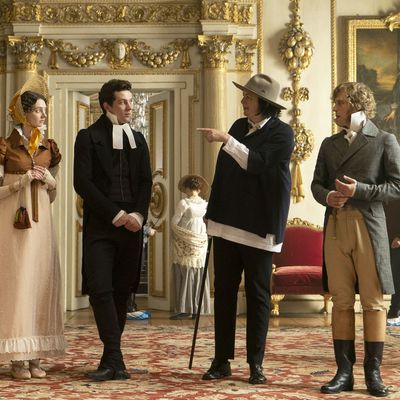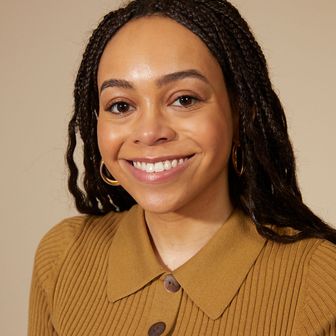
The latest adaptation of Emma. — with a period at the end — arrives as a confection: ruffles and pastels and sweetly embarrassing ailments. A heroine’s nosebleed spurts in the middle of a declaration of love; a cynical dad doesn’t glide down a stately staircase, he hops down them. For her first feature film, the rock photographer Autumn de Wilde wanted to adapt Jane Austen’s frustrated hero to a period piece dramedy. By phone, de Wilde recounted nine artists, ballets, movies, and “sexy ballet movies” that anchored her own offbeat coming of age.
1. Pollyanna (1960)
When video stores became a reality when I was 17 or 18 and we had a VHS, I rented Pollyanna. I was obsessed with Hayley Mills. When my daughter was born, I bought it, and then she and I watched it. I have a funny obsession with the early live action Disney movies. The score is like treating the movie as if it’s an animated film. I’ve always loved the music in [Pollyanna] — some would probably feel it was too obvious and childlike, but I’m drawn to that. I wanted that in the music in this movie. Emma is intelligent beyond her years, except she’s very emotionally stunted. But she really is the woman of the house from a young age and she doesn’t have a mother. The childlike music encouraged her bad behavior, and then the folk music was this earthy depth to the world around her, and the sort of real people in the town. Then there are few traditional classical pieces in it that really reflect maybe the heightened emotional state of the story, and the maturity that’s coming to Emma.
2. The Turning Point (1977)
I used to rent ballets. I was so into The Turning Point! To me, that was steaming hot. There’s a really amazing fight in The Turning Point between Shirley McClain and Anne Bancroft, and Baryshnikov is in it, who I was very hot to trot for. Emma. has a ballet-like quality to it on purpose. There is a lot of choreography in the way the actors move. The rule was they needed to deal in sincerity always, but there was this sort of artificial [quality] to the complex choreography they were all doing physically. They just started doing it as if it was second nature, and in a way, it made the movie a little bit like a ballet with words.
3. Bringing Up Baby (1938)
Screwball comedy is a huge influence on me. I made the whole cast watch Bringing Up Baby. In those comedies like Bringing Up Baby and His Girl Friday, there’s a set of rules, a formality to the behavior and society. There is a little bit of a class system in the way the society is presented in Emma, and that’s why that screwball element works, because all the squares are so shocked by the behavior of the wild one. It works well with this Regency period in 1815: there are these rigid social rules and class separation, but they did love to have fun. If someone started playing music, the carpet would get rolled up, furniture moved aside, and they would all want to dance. The screwball comedy was a way of showing both sides of those characters in a way that I wanted to exaggerate.
4. Van Gogh
When I was a kid, I went to museums a lot with my mom, happily. But I had this fatigue I didn’t identify until later. There’s a term for a sort of art fatigue. It happens to people in Florence: there’s so much incredible art they almost become depressed and can’t function. I was so easily visually stimulated, I didn’t realize I would get this fatigue and just wished I could fall asleep on the bench in the middle of the gallery. I probably often did.
I really wanted to look at every piece of art, and I was so annoyed I was exhausted that I started simplifying what I was looking at. I started playing this game when I was little to collect color combinations. I’d go up to a painting, but I didn’t read who it was or when it was painted. I didn’t look at what the painting might mean or the theme of it. I looked specifically at the color combinations that I liked, and I would think to myself, “Oh, that’s interesting. Turquoise, yellow and orange, I never thought of that.” I started seeing Van Gogh paintings that way, which is interesting when you’re just collecting color combinations. For the movie, when I was doing my research, I realized how colorful the Georgian period was. We’d really been looking at faded wallpaper and faded clothing in museums. A lot of movies were presenting this time period in faded antique creaming yellows and browns. I went to this place, Andrew Edmonds in London, and he has this enormous collection of caricature and fashion illustrations. I poured over those colors doing the same thing, collecting color combinations for Emma.
5. Mon Oncle (1958)
It has almost no dialogue in it. The colors are fucking incredible. Jacque Tati was kind of like the French Charlie Chaplin. And I just loved how much of that story can be communicated without words. And if you look at Emma, there are a lot of passages without words that you maybe wouldn’t realize people aren’t talking. For me, the script is one layer of storytelling. The actor develops the other script, which is what’s really going on. What are they really thinking? What are they really trying to get? And then we can have competing stories happening within one scene.
6. “Peter and the Wolf”
I had a couple of records as a kid that were like the equivalent to me of watching cartoons. I was just as happy to listen to that record, both sides, all day. “Peter and the Wolf” really brought the orchestra to life for me — the instruments were animals, the animals are instruments. And also I suppose because I studied ballet for 14 years, classical music was intertwined in my life — it was my first real obsession.The direction I gave [Emma.’s composer] Isobel Waller-Bridge was that I wanted the movie to feel like the orchestra’s misbehaving, or perhaps the conductor’s overwhelmed.
7. Beck
I shot Beck for about 15 years on and off. He introduced me to most of the folk music I’m aware of. He is an incredible library of music knowledge. He’s also an incredible library of art and literature and cinema. He brought a lot of influence into my creative palette. My interest in folk music started pretty young, but I learned a lot [from him] about it and how it affected rock and roll in America and in England. It was important to me to put folk music from that time period into the movie because it’s an interesting duality. There’s the polite classical music of the drawing room, and then the sort of folk songs that were sung as women sewed and washed clothes. Jane Austen herself was a big fan of folk music. She had a large collection of hand-copied music in her own personal collection, like 500 pieces of music. She loved Irish folk songs.
8. When Harry Met Sally (1989)
I wouldn’t say When Harry Met Sally is my favorite movie in the world, but it pinpointed something that everyone connects to: the I-didn’t-know-I-was-in-love-with-my-best-friend thing. That obviously comes from Emma. Jane Austin pinpointed it in the Emma-Mr. Knightley relationship. It’s been used successfully as a thematic problem in two people’s lives in a lot of stories, and that’s really a testament to Jane Austin’s observation of the romantic human condition.
9. Harold and Maude (1971)
It’s one of my favorite movies of all time. I love how dark, but how full of hope and light it is. There’s very few movies that could end with a death and a fake suicide that could make me feel happy, and that’s pretty incredible. I also love that Harold is sort of an anti-hero. Like Emma, he’s privileged and spoiled. He has good reason to be upset with his mother. But Maude really shows him how to be a real human, even in both of their fascinations with death. And in a way, takes his eyes and points to all the things he was looking at in funerals and fake suicides and shows him that what he’s really looking at is the beauty of life. And that he can be mad, but he can also participate in that. It was my favorite teen movie, even though it wasn’t a teen movie. My friend made me watch it on VHS in junior high. And it changed my life.


